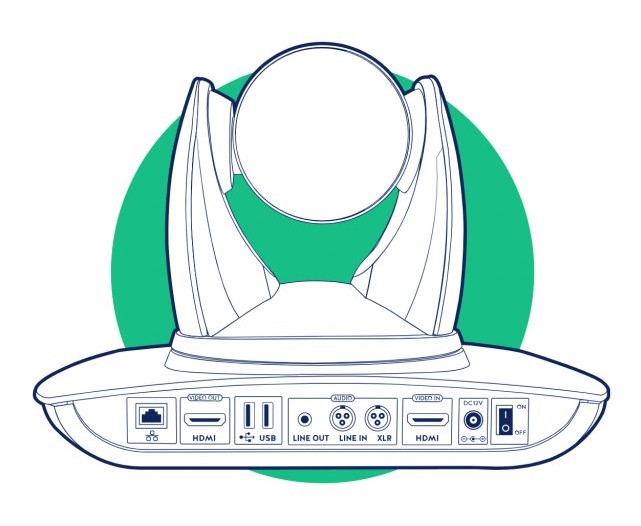

We had the honor of hosting Dominique Jaccard on July 7th, an audio engineer and integration manager at Aix Marseille University for about a year. With a background in the entertainment industry, Dominique is passionate about audiovisual technology. He joined us to share his advice and answer your questions live, focusing on achieving high-quality audio in your rooms and lecture halls, even at a distance!
For meaningful interaction with remote students, the sound from the lapel microphone of the instructor or a handheld microphone won't be sufficient. The student will be too far away, resulting in an excessively weak audio signal. You need to capture audio within the lecture hall. Many options exist depending on the room or lecture hall size.
In rooms with relatively low ceilings, you can use ceiling tiles. Brands like Shure, Sennheiser, and Yamaha offer these options. Alternatively, you can use room microphones like Sennheiser's static microphones, which can be positioned in a corner of the lecture hall on a stand. Of course, they should be out of reach to prevent theft. Another option is to provide a handheld microphone that students can pass to one another if they want to participate.
We mainly use Sennheiser's range of products. We tested both Shure and Sennheiser ceiling tiles. The results we obtained in terms of voice tone and capture from different positions in the room led us to choose Sennheiser. While Shure's tiles also have many qualities, they're better suited for different contexts.
Both ceiling tiles employ advanced technology and are quite expensive. However, Sennheiser's option is slightly more cost-effective than Shure's.
Ceiling tile technology is recent and wasn't yet in place before last year. Covid acted as a catalyst for implementing distance learning and capture technology. Before, we only had speakers and handheld microphones in the lecture halls.
Ceiling tiles are suitable for small to medium-sized rooms, up to 50-60 people. Beyond that, you would need to increase the number of tiles or compromise on quality by positioning tiles further from the presenter due to higher ceilings.
Yes, Sennheiser developed a control application called Cockpit. It provides a comprehensive visualization of microphones for tiles connected to the network. You can remotely configure and monitor everything on a site-by-site basis.
Absolutely, our networks are separate. In Aix-en-Provence, we control the microphones there, and in Marseille, we control the ones there. The software provides an overview of the room with essential information: whether the tile is on, connected, its capture direction, sound orientation, volume, and lighting direction (indicated by small red or green lights). We can attenuate capture on the backside of the tile to focus on the instructor.
I don't have the exact number, but there are many!
A sound system with speakers must also be installed and is part of the prerequisites.
The instructor connects their PC or Mac via USB to a device in the room that relays the computer's camera and microphone. They also connect an HDMI cable to project remote participants onto the projector screen along with their audio.
There's always a degree of uncertainty about what lies ahead. The momentum created for distance learning will continue. We've developed new habits and perhaps even identified new needs. User demand is different from what was done previously, and we've found it very practical. This approach with cameras, microphones, etc., will persist, especially for students who can't physically attend due to physical constraints. So, this dynamic involving cameras, microphones, etc., will continue.
We've never tested mounting them on walls, but it seems complicated due to the direction of capture lobes. It's not impossible, but management would be much more challenging.
Everything had to be done in a rush; the situation was sudden. The bottom line is that for good capture and results, investment is necessary. Avoid opting for entry-level equipment; a €200 microphone will never yield the same results as a €4000 ceiling tile.
A great question! We have different configurations depending on the number of microphones used in the room. Sometimes we use up to 8 or 10 microphones, employing a digital or analog mixer before the signal reaches the camera. This allows us to mix all the sources. We either embed them in the HDMI signal (video and sound in a single cable to the camera) or output the mixer's signal to the Kast's XLR inputs.
In certain rooms, we directly connect Sennheiser ceiling tiles to the Kast camera using the analog connection of the Sennheiser tile.
Yes, we have rooms set up for conferences with up to 8 microphones. We use various types of microphones, including gooseneck microphones on the table mixed with handheld microphones and lapel microphones. In these cases, a mixer is necessary.
A ceiling tile can capture sound from a relatively far distance (around 4 to 5 meters). However, the farther the tile is from the presenter, the more the acoustic interaction with the room becomes significant. Beyond 5-6 meters, the interaction with the room becomes predominant, resulting in unpleasant sound.
For a lecture hall with 300 seats, it's not just the number of students to consider; the ceiling height matters. Is it 5 meters or 12 meters high? In the latter case, you would need to lower the ceiling tile as much as possible, but that introduces other constraints. For example, when lowered, the tile might obstruct the projector, or you would need to position it on the side.
The camera has several audio input sources. It has an HDMI-in connector and two mini XLR inputs with standard adapters for connecting microphones. Additionally, there's a "line out" jack where you can retrieve all the audio signals entering the camera for external use.
If two microphones are connected to the camera, is it currently possible to differentiate between the two audio sources using the Kast Remote application? Do you have any microphone recommendations that can be directly adjusted, such as for muting?
Yes, there's indeed a way to address the absence of separate adjustment for the two signals. You can use a wired microphone with a mute button. For example, Sennheiser's wired microphone series like 835, 945, 935. By adding an "S" at the end, you get the same microphones with an on-off switch. Almost all wireless microphones with transmitters and receivers also have a mute position.
You need to go to the audio menu and lower the faders between 10% and 30% while increasing the level of the incoming source.
We thank Dominique Jaccard for accepting our invitation! If you want to learn more about the implementation of comodal and hybrid learning at our clients' institutions, we recommend checking out this article: "Comodal and Hybrid Teaching: The New Post-COVID-19 Paradigm."


